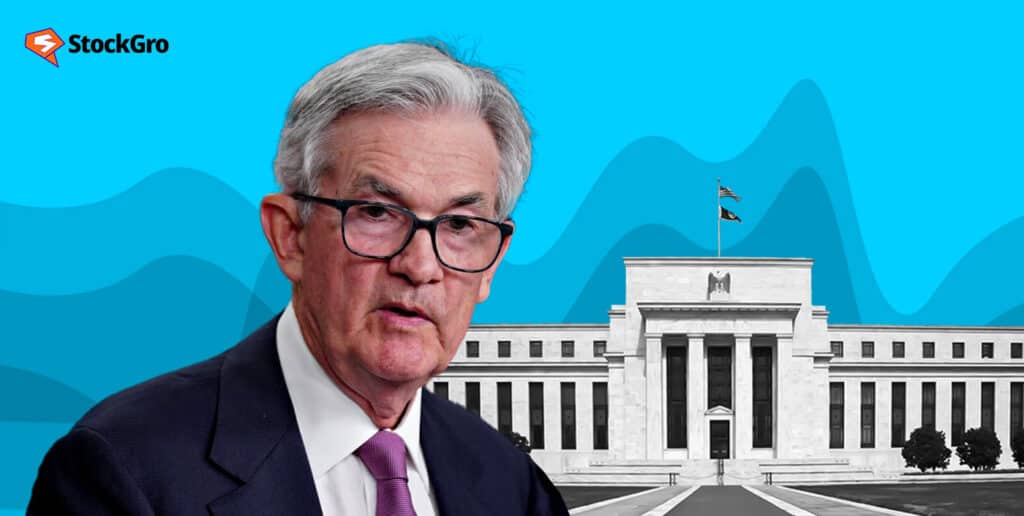
The US Federal Reserve recently published its policy outcome, keeping the interest rates the same. This monetary policy announcement took place after the Reserve Bank of India’s (RBI) Monetary Policy Committee’s (MPC’s) report of its fifth monetary policy decision for FY24 earlier this December.
During its last policy meeting on November 1, the Federal Open Market Committee (FOMC) decided to maintain the current range of 5.25 to 5.50% for the benchmark overnight interest rates.
This year, the central bank has maintained interest rates for the second consecutive month. Since inflation is still higher than the Federal Reserve’s 2% target, the Fed kept interest rates unchanged at its third meeting in December.
The FOMC raised interest rates eleven times in less than a year and a half, raising the primary federal funds rate to an achievable range of 5.25–5.5%. Since the beginning of 2001, it has been the highest.
In today’s article, we will cover the highlights of the US Federal Reserve policy meeting that took place in December this year.
But first, let’s understand the duties of the US Fed, how the pandemic affected the US economy, and what measures the Fed took to address the impacts through its monetary policy. Let’s begin!
Also read: How does the US Fed’s interest rate pause impact global markets and India?
Understanding the US Federal Reserve’s monetary policy
The Federal Reserve, often called the Fed, is the most influential financial organisation in the US. The Fed oversees many things, including the money supply, controlling financial markets, and setting interest rates. These are the primary ones.
We have also seen the Fed serve as a lender in times of economic crisis, like during the pandemic and the Great Recession of 2008.
However, regarding the main goal, the Fed focuses on building a stable and secure financial system for the US. The Federal Reserve involves twelve Federal Reserve banks, each having its president and functioning as a distinct district.
The primary committee of the Federal Reserve that sets monetary policy is called the Federal Open Market Committee (FOMC). It is in charge of open market activities, which include investing and selling government securities to impact the money banks reserve.
The Federal Reserve Board of Governors, Federal Reserve Banks, Federal Open Market Committee, and all the initiatives that the Fed forms are meant to carry out its dual mandate (maximum employment and stable prices).
To support the highest level of employment, price stability, and low rates of long-term interest in the US economy, the Federal Reserve sets the country’s monetary policy.
How has the Fed responded to the post-pandemic US economic effects?
The pandemic certainly struck hard in the US, forcing thousands of businesses to close and millions of people to lose their jobs in 2020. The impact also led to a historic 29.9% decline in second-quarter GDP.
However, the Fed adopted an aggressive fiscal policy and a lower-for-longer monetary policy (when interest rates stay low for extended periods because of slow economic growth). The result? The US witnessed the strongest recovery in jobs in the last forty years.
This year, it’s true that many expected a slowdown in 2023 since inflation is still high and the Fed is committed to lowering it via the tight monetary policy of the US federal reserve.
And many hoped that inflation could be controlled without causing a recession, given the strength of the job market, investment from the private sector, and consumer spending.
Also read: How to Invest in US Stocks from India?
US Federal Reserve policy outcomes: Key highlights
After a two-day meeting, the Fed released the FOMC statement. The statement indicates that current economic indicators are pointing to a slowdown in the recovery of economic activity following a robust third-quarter pace.
Here are the most significant updates that we can get from the monetary policy released by the Fed in December:
- At the US Federal Reserve policy meeting, the Fed held its benchmark interest rate at its highest level in the last twenty years, between 5.25% and 5.50%. The members anticipate lowering its benchmark interest rate by 75 basis points (bps) in 2024.
- The Fed’s benchmark rate is crucial because it affects every facet of consumers’ financial lives, from the interest rates they pay on loans to the amount of interest they get on savings.
- The FOMC members also indicated that they now expect a 0.75% point of interest rate decline.
- In 2024, the GDP is expected to contract to 1.4%, according to the FOMC members. This year, the US economy is projected to grow by 2.6%, up from 2.1% in September.
- The headline inflation rate is also anticipated to drop to 2.8% in 2023 and 2.4% in 2024. The committee also clarified that the Fed is firmly committed to lowering inflation back to its target of 2%.
- The US central bank said in an announcement that the Fed’s decision to maintain its benchmark lending rate between 5.25 and 5.50% allows the FOMC members to decide the level of any further policy tightening that may be appropriate.
- According to Jerome Powell, the Fed’s “appropriate” time to start reducing interest rates was discussed among officials, who declined to rule out another rate rise.
- Fed Chair Jerome Powell informed the press that the addition of the word “any,” which was not there in the decision made in November, indicated that they are convinced they might be close to the highest rate ever recorded for this cycle.
- Powell said that robust consumer interest and better supply factors are why economic growth looks to have slowed “substantially” in the fourth quarter of 2023 but is still expected to continue.
- The Fed is still pointing out that inflation is still high. However, the Fed conceded that inflation has moderated over the last year.
Also read: Why is the US dollar the ‘currency of the world’?
Conclusion
As we can see, the US Fed’s monetary policy has maintained its decision, keeping the economic outlook in mind. Regardless of whether the Fed lowers interest rates in the coming year, it is highly likely that borrowing costs will remain higher than they were during the pandemic.
Keeping this in mind, it is advisable to improve your credit score and consider paying off high-interest loans and putting your money in places like savings accounts where you can park your cash.

